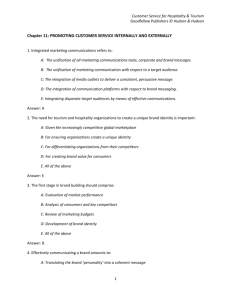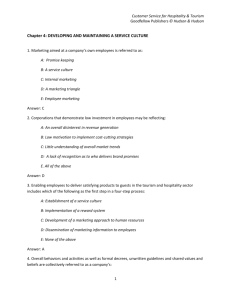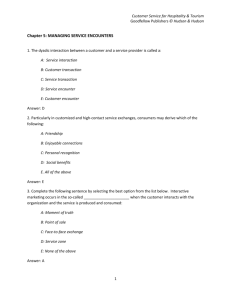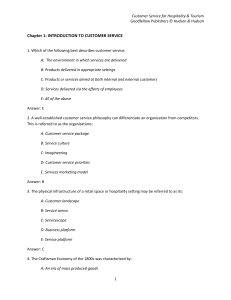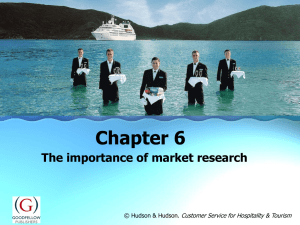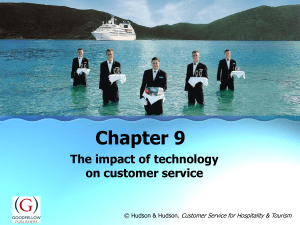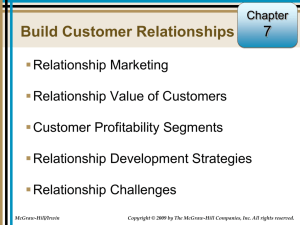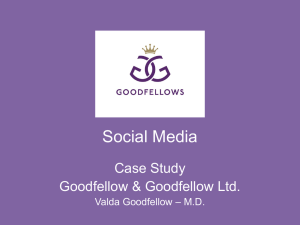Chapter 7 test questions
advertisement
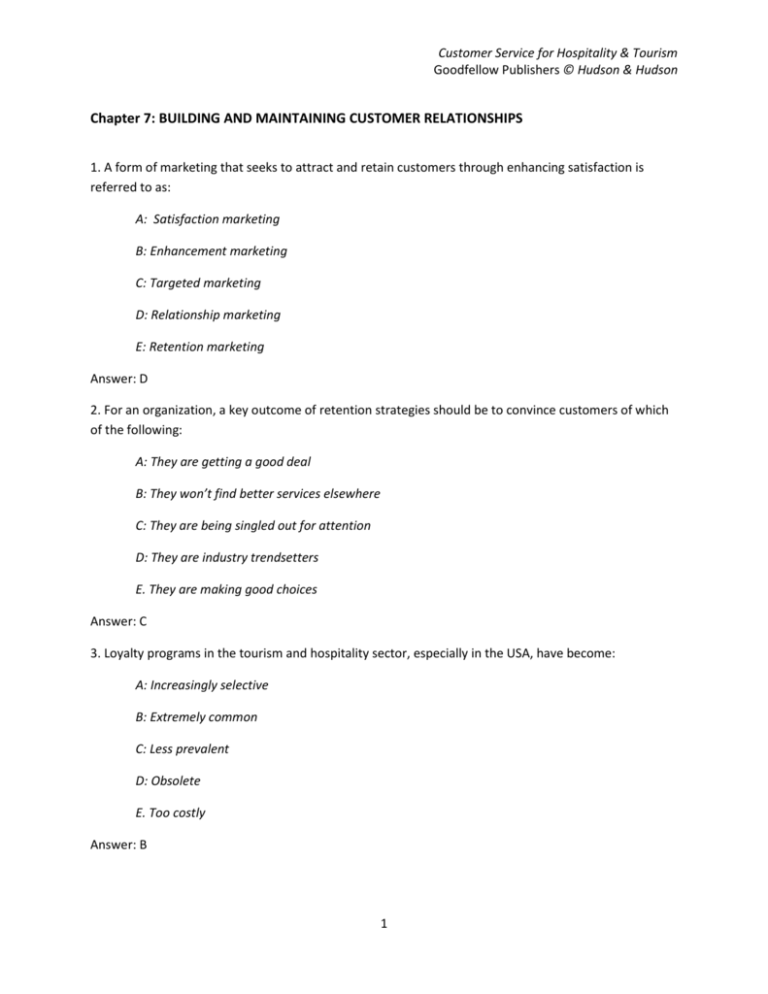
Customer Service for Hospitality & Tourism Goodfellow Publishers © Hudson & Hudson Chapter 7: BUILDING AND MAINTAINING CUSTOMER RELATIONSHIPS 1. A form of marketing that seeks to attract and retain customers through enhancing satisfaction is referred to as: A: Satisfaction marketing B: Enhancement marketing C: Targeted marketing D: Relationship marketing E: Retention marketing Answer: D 2. For an organization, a key outcome of retention strategies should be to convince customers of which of the following: A: They are getting a good deal B: They won’t find better services elsewhere C: They are being singled out for attention D: They are industry trendsetters E. They are making good choices Answer: C 3. Loyalty programs in the tourism and hospitality sector, especially in the USA, have become: A: Increasingly selective B: Extremely common C: Less prevalent D: Obsolete E. Too costly Answer: B 1 Customer Service for Hospitality & Tourism Goodfellow Publishers © Hudson & Hudson 4. Complete the following sentence by selecting the best option from the list below. Greater attention to the needs of individual customers is based upon a number of studies that have demonstrated dramatic increases in profits as a result of _____________________ customer retention rates. A: Large increases in B: Small increases in C: Stabilizing D: Enhancing E. Sustained increases in Answer: B 5. According to Winer’s (2001) model, the first step in managing customer relationships is the construction of a customer database to include all of the following information EXCEPT: A: Customers’ transaction history B: Customer contact information C: Descriptive information about customers D: Customers’ family and social relationsips E: Customer responses to marketing stimuli Answer: D 6. Which of the following is NOT considered one of the four retention strategies defined by Zeithaml and Bitner (2000): A: Personal bonds B: Customization bonds C: Social bonds D: Financial bonds E: Structural bonds Answer: A 7. Complete the following sentence by selecting the best option from the list below. Thomas Cook Travel was one of the first tourism organizations to calculate the ___________________ of its customers. 2 Customer Service for Hospitality & Tourism Goodfellow Publishers © Hudson & Hudson A: Loyalty B: Expendability C: Profitability D: Marketability E: Manageability Answer: C 8. A trend in customer loyalty programs whereby single-brand loyalty programs are turned into corporate-wide programs, or businesses partner with other businesses in offering points and associated benefits, is captured in the: A: Partnership model B: Bonus reward model C: Coalition model D: Point swap model E: Loyalty model Answer: C 9. Strategies to increase loyalty through intimate knowledge of individual customers and development of one-to-one solutions that meet individual customer’s needs is referred to as mass customization or: A: Customer advocacy B: Loyalty techniques C: Personalized service D: Customized strategies E: Customer intimacy Answer: E 10. According to Dick and Basu’s (1994) framework, latent loyalty best describes customer who exhibits which of the following behaviors: A: Strong brand preference but situational or environmental constraints B: High frequency purchases of a brand and low motivation to search for alternatives 3 Customer Service for Hospitality & Tourism Goodfellow Publishers © Hudson & Hudson C: High frequency purchases of a brand but low brand differentiation D: Low frequency purchases of a brand and low brand differentiation E: Low brand preference but no situational or environmental constraints Answer: A 11. Customer benefits from long-term associations with companies include all of the following EXCEPT: A: Special treatment B: Lower costs C: Reduced risk D: Increased value E: Customized services Answer: B 12. Finish the following sentence by selecting the best phrase from the list below. A key role of marketing is to identify customers with value-creating potential and target them with ____________________ to reduce the risk of defection. A: Management strategies B: Marketing strategies C: Promotional offers D: Retention strategies E: Sales strategies Answer: D 13. The 80/20 customer pyramid proposed by Zeithhaml and Bitnen (2000) suggests which of the following regarding customer behavior over time: A: 80% spread positive word of mouth B: 20% complain the most C: 80% cost the least to maintain D: 80% are the most profitable E: 20% are the most profitable 4 Customer Service for Hospitality & Tourism Goodfellow Publishers © Hudson & Hudson Answer: E 14. In Kumar and Rajan’s 2009 classification scheme on loyalty and profitability management, ‘Butterflies’ are described as customers who: A: Have consistent profit potential B: May have high profit potential C: Have the highest profit potential D: Have the lowest profit potential E: May have low profit potential Answer: B 15. In Watson and Kale’s (2003) taxonomy of casino customer segments, customers with high future relationship value as well as high profitability are referred to as: A: Lucrative customers B: Prime customers C: Valued Customers of Tomorrow D: Incidental Customers E: Mobile Customers Answer: B 5
